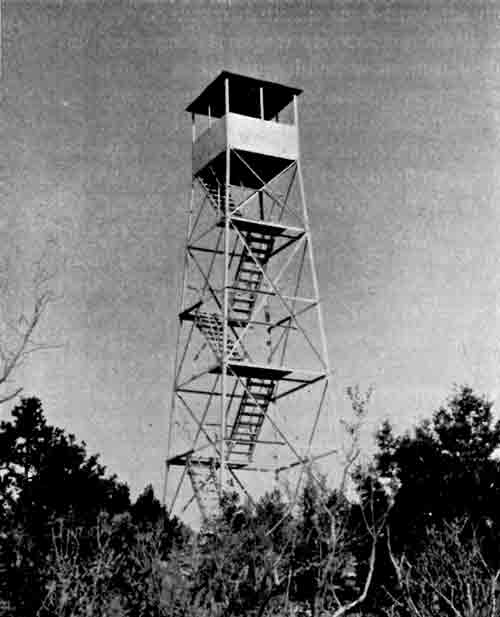|
NATIONAL PARK SERVICE
Park and Recreation Structures |

|
FIRE LOOKOUT STRUCTURES
THE PROMPT DETECTION of any forest fire that may start is a basic necessity for the efficient protection of forested parks. In order to provide for early discovery and immediate report of size, location, and condition of fires before they become large, it is necessary that trained observers be so stationed that they can keep the forest under constant observation. These stations are usually located on heights which overlook the greatest possible expanse of danger area, and particularly on those which cover the most probable points of fire origin.
The need, location, and number of lookouts required for adequate fire detection in a given park are determined after carefully conducted lookout studies, not by arbitrary selection of the highest vantage points. The best single point or combination of points to afford the maximum coverage of fire danger areas is selected. Efficient range of visibility does not exceed 10 to 15 miles, due to haze and other vision-limiting factors; therefore, even though a point may provide views of areas much further removed, this additional coverage cannot be given much weight in determining lookout locations.
In selecting the type of structure best adapted for any particular site several considerations are involved.
Unobstructed visibility in all directions in which a fire may occur is of primary importance. If the site is on flat topography, or a shoulder of ridge or mountain cuts off the view, or trees are nearby, which for aesthetic or other reasons cannot be removed, it is necessary to raise the observatory above the ground. On sites which provide clear visibility of the entire danger area, the structure can be a one- or two-story building.
Adequate, safe, and comfortable living quarters for the observer are another important consideration. For efficient fire detection it is essential that the observer live in his lookout unless precluded by height of structure. Since fires can and do start at all hours of the day and night, he must be constantly on the alert and in a position to observe them promptly. If the observer lives away from his station, the fire may burn a long time before being discovered. Since most lookout structures are on exposed sites, adequate protection from lightning, wind, storm, and sun must be provided. Where high towers (exceeding 16 feet in height) are necessary for detection, the lookout's living quarters should be close to the base of the tower, so located that all possible detection of the area is provided from that point. Provision should be made for storage of food and other supplies and equipment, and also for water, if no source of supply exists on the site. This storage space for supplies is especially necessary in isolated locations where servicing of lookouts is made at infrequent intervals.
Efficient detection of fires requires the use of delicate and costly equipment including the telephone or radio and fire locating and other instruments. It is vitally necessary that these be protected from exposure by adequate housing.
Since lookouts are located on vantage points selected for their broad coverage of forest, they are also the best points from which the public can view the finest scenic panoramas. A well-designed structure and a properly trained lookout observer can contribute to the enjoyment of the park by the public, and the observer is offered a chance to sell fire protection painlessly to the visitors.
SEVERAL TYPES OF STRUCTURES have been designed for efficient fire protection, including a simple single-room building 14 by 14 feet which combines living quarters and observatory, a two-story building with observatory above and storage space below, a low tower with 14 by 14 feet observatory on top, and finally the higher steel towers, some of which are 65 feet high with smaller enclosures. In designing the structure it is essential that the observatory provide the maximum of unobstructed visibility, using plate glass and narrow corner posts. Adequate protection against lightning, high winds, and winter storms, and the factor of live load due to a concentration of visitors must be taken into account in designing the lookout.
The safety of the visitors must be considered if it is anticipated that the public will visit the lookout. It is generally desirable to provide a walkway or platform around the observatory to accommodate visitors and to permit the observer to examine the area from outside the observatory. High towers must be provided with railings along the steps, platforms, and landings. Landings are desirable to break a monotonous and strenuous climb to the top of a high tower. Ladders are not satisfactory on towers visited by the public.
Since fire lookouts must be placed on prominent points for efficient fire protection, they are frequently visible for considerable distances. They should, therefore, be designed with thought for their appearance. It is possible by employing native rock or logs in the construction to achieve a certain harmony with the surroundings, especially if, when located on a rocky summit, the structure is blended to it and made to appear to grow out of it. However, where it is not feasible to hide the structure without decreasing the efficiency of the lookout, or there is not opportunity for blending the structure to location, the benefits derived from fire detection and the public's interest in the operation itself as a conservational activity of the park area go far to offset any aesthetic shortcomings of the facility itself.
The fire lookout shown directly below exemplifies the functional fire lookout tower, divested of all the gestures to park environment so conspicuous in the timber-framed tower delineated on the following page.

Fire Lookout Tower, Grand Canyon National Park
| <<< Previous | <<< Contents>>> | Next >>> |
park_recreation_structures/part1j.htm
Last Updated: 04-May-2012